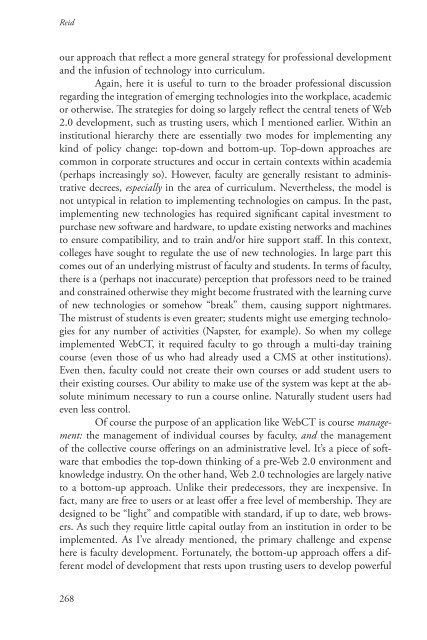Design Discourse - Composing and Revising Programs in Professional and Technical Writing, 2010a
Design Discourse - Composing and Revising Programs in Professional and Technical Writing, 2010a
Design Discourse - Composing and Revising Programs in Professional and Technical Writing, 2010a
Create successful ePaper yourself
Turn your PDF publications into a flip-book with our unique Google optimized e-Paper software.
Reid<br />
our approach that reflect a more general strategy for professional development<br />
<strong>and</strong> the <strong>in</strong>fusion of technology <strong>in</strong>to curriculum.<br />
Aga<strong>in</strong>, here it is useful to turn to the broader professional discussion<br />
regard<strong>in</strong>g the <strong>in</strong>tegration of emerg<strong>in</strong>g technologies <strong>in</strong>to the workplace, academic<br />
or otherwise. The strategies for do<strong>in</strong>g so largely reflect the central tenets of Web<br />
2.0 development, such as trust<strong>in</strong>g users, which I mentioned earlier. With<strong>in</strong> an<br />
<strong>in</strong>stitutional hierarchy there are essentially two modes for implement<strong>in</strong>g any<br />
k<strong>in</strong>d of policy change: top-down <strong>and</strong> bottom-up. Top-down approaches are<br />
common <strong>in</strong> corporate structures <strong>and</strong> occur <strong>in</strong> certa<strong>in</strong> contexts with<strong>in</strong> academia<br />
(perhaps <strong>in</strong>creas<strong>in</strong>gly so). However, faculty are generally resistant to adm<strong>in</strong>istrative<br />
decrees, especially <strong>in</strong> the area of curriculum. Nevertheless, the model is<br />
not untypical <strong>in</strong> relation to implement<strong>in</strong>g technologies on campus. In the past,<br />
implement<strong>in</strong>g new technologies has required significant capital <strong>in</strong>vestment to<br />
purchase new software <strong>and</strong> hardware, to update exist<strong>in</strong>g networks <strong>and</strong> mach<strong>in</strong>es<br />
to ensure compatibility, <strong>and</strong> to tra<strong>in</strong> <strong>and</strong>/or hire support staff. In this context,<br />
colleges have sought to regulate the use of new technologies. In large part this<br />
comes out of an underly<strong>in</strong>g mistrust of faculty <strong>and</strong> students. In terms of faculty,<br />
there is a (perhaps not <strong>in</strong>accurate) perception that professors need to be tra<strong>in</strong>ed<br />
<strong>and</strong> constra<strong>in</strong>ed otherwise they might become frustrated with the learn<strong>in</strong>g curve<br />
of new technologies or somehow “break” them, caus<strong>in</strong>g support nightmares.<br />
The mistrust of students is even greater; students might use emerg<strong>in</strong>g technologies<br />
for any number of activities (Napster, for example). So when my college<br />
implemented WebCT, it required faculty to go through a multi-day tra<strong>in</strong><strong>in</strong>g<br />
course (even those of us who had already used a CMS at other <strong>in</strong>stitutions).<br />
Even then, faculty could not create their own courses or add student users to<br />
their exist<strong>in</strong>g courses. Our ability to make use of the system was kept at the absolute<br />
m<strong>in</strong>imum necessary to run a course onl<strong>in</strong>e. Naturally student users had<br />
even less control.<br />
Of course the purpose of an application like WebCT is course management:<br />
the management of <strong>in</strong>dividual courses by faculty, <strong>and</strong> the management<br />
of the collective course offer<strong>in</strong>gs on an adm<strong>in</strong>istrative level. It’s a piece of software<br />
that embodies the top-down th<strong>in</strong>k<strong>in</strong>g of a pre-Web 2.0 environment <strong>and</strong><br />
knowledge <strong>in</strong>dustry. On the other h<strong>and</strong>, Web 2.0 technologies are largely native<br />
to a bottom-up approach. Unlike their predecessors, they are <strong>in</strong>expensive. In<br />
fact, many are free to users or at least offer a free level of membership. They are<br />
designed to be “light” <strong>and</strong> compatible with st<strong>and</strong>ard, if up to date, web browsers.<br />
As such they require little capital outlay from an <strong>in</strong>stitution <strong>in</strong> order to be<br />
implemented. As I’ve already mentioned, the primary challenge <strong>and</strong> expense<br />
here is faculty development. Fortunately, the bottom-up approach offers a different<br />
model of development that rests upon trust<strong>in</strong>g users to develop powerful<br />
268


















